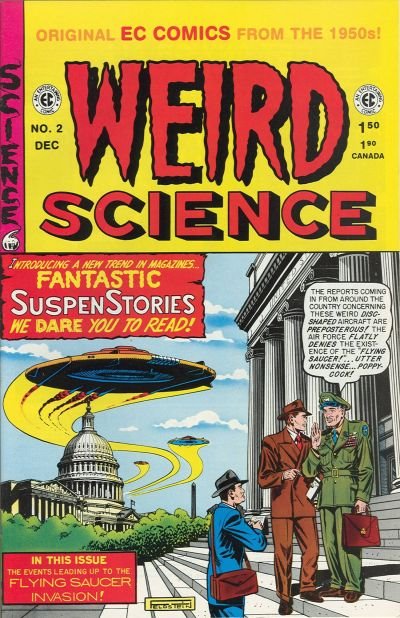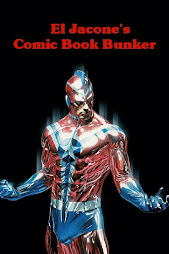
Weird Science #13/2
The kids these days, they don't know how good they got it.
As anyone reading this probably knows, back in the days of Newsstand distribution, there was a postage fee involved for publishers putting out a new #1 -- obviously, Marvel and DC as we know it would never be able to function in such an environment. But publishers at the time took this in stride, including Bill Gaines over at EC. See, Weird Science was one of the many horror, crime, and science fiction format mags which EC was starting to put out to an eager audience of boys in the early 1950s. Before transitioning into aliens and mad scientists, this series was known for it's first eleven issues as Saddle Romances (I think there is something to be said that WS replaced not just a Western book, but a Western Romance book). Well anyone expecting prarie love and heartache was in for a big shock with #12, and it continued in the next installment, which is what we are looking at today.
Now, obviously, I didn't find an original copy of Weird Science #13/2 in a discount bin. But my brother did happen to find a Russ Cochran/Gemstone reprint copy while at a comic book show, and he was kind enough to give it to me. I'm a big fan of the "Big Three" EC horror books -- Tales From The Crypt, The Haunt of Fear and personal favorite Vault of Horror -- but I unfortunately had never read much of their "weird" books, which also included Weird Fantasy. I like science fiction almost as much as I like horror, so I was eager to check out this blast from the past.
Like any good EC title, this is an anthology, with four main features, plus a pair of single-page text pieces to keep us entertained. Each is lettered in the classic EC all-caps block style, which, combined with the "house style" of the art (from the EC mainstays) and Al Feldstein's unstoppable brain, makes for a unique comic experience.
The first feature is titled, straight-forwardly enough, "The Flying Saucer Invasion," which is written and drawn by Feldstein. People all over the country start to see UFOs in the sky, and, like all good Americans, report them to the government. A federal investigator is called in to quell the "UFO panic," and using deductive reasoning, is able to dismiss the "wild" claims of the gullible dupes who have bought into this UFO stuff. So once can imagine the egg on his face a government space observation station spots a giant fleet of saucers heading straight for the unarmed and unprepared Earth! Read enough EC comic books and you will quickly get familiar with this type of character archetype: The Smug Smart Guy. Too smart for their own good, they inevitably "prove" something to be untrue, only to have that untruth come back to bite them where it hurts.
Next up is "The Meteor Monster," which reminds me of a mix between The Thing From Another World and The Beast With A Million Eyes. A small alien crashlands on Earth, and quickly dominates the mind of any human whom it looks in the eyes. Quickly taking over the entire town, our astro-fiend has designs to control the entire planet, but they don't really stick when the town's one blind guy manages to break everyone free from his control -- unleashing their righteous anger in the process. Needless to say there is a little nest of the aliens hiding out that the humans don't notice, but you knew that, right? Alliterative artists Wally Wood and Harry Harrison (who would later go on to pen the inspiration for Soylent Green) team up for this quirky little story.
The next installment is our first text peice, ominously entitled "The Experiment." Like most of these quickie stories from the period, it's not very good, but it's not entirely unreadable like some, either. Considering that a lot of these were done to get the content count up for postage purposes, it's usually a roll of the dice anyway. Essentially, scientists trying to observe the heavens end up sending the entire universe out of whack (as scientists will do).
Our third feature is entitled "The Micro Race," and if this Feldstein and Jack Kamen effort was not the inspiration for the classic Simpsons bit "The Genesis Tub," I'd be really surprised. A scientist (using RADIOACTIVITY!) creates a microscopic race of organisms who live at an accelerated rate in order to study the history of humanity. Needless to say, the tiny race is much more humanlike than the scientist initially predicts, and they begin not only to settle their internal conflicts violently, but also to aggressively defend their very existance against "higher powers." A story like this seems quaint now, but in 1950, this was pushing it. It's a familiar theme but a nice riff on it.
The second and last text story, "Sands of Time," is better than the first one. Dealing with a strange kind of sand which began in a farmer's yard in South Carolina, the silicate substance spreads to cover the entire East Coast. Told as a series of AP articles, everything is presented very matter-of-factly, with no embellishment or explanation beyond the facts. Pretty interesting considering the brevity, really.
Finally, the fourth feature, "The Man Who Raced Time," drawn by none other than Harvey Kurtzman (of Mad fame), stars a somewhat-mad scientist of the "Fools! I'll destroy them all!" school. Repeatedly spurned by the pretty young professor he lusts after, he uses his experimental machine on himself, speeding him up faster than the eye can see. This allows him to causes all sorts of trouble in a (failing) effort to win his lady love's affections. But when the gal decides to marry her handsome suiter, the scientist's attempts at engineered vehicular manslaughter go all sorts of wrong. The simple moral here -- chasing pretty girls will inevitably be the death of you -- is pretty universal. Seriously though, I really liked the ending to this one, which is pretty immediate in it's impact and also touches on the Smug Smart Guy archetype a bit too.
All in all, you get 31 pages of weird fun, a pretty good return on investment considering that this reprint cost $1.50 when it was published, and only put my brother back a buck or so. That's the value of anthology titles right there. None of the stories are really outstanding, but they make for diverting reading and are short enough that you can read one without getting too involved. The art is strong throughout, with the four artists each unique but thematically tied together. Of course, we all know what would befall EC a few years after this was initially published, but that doesn't mean we can't all enjoy the fruits of their labors some 50 years after the fact. With RC and Gemstone reprinting various EC titles in the early-to-mid 90s, plus the new hardcovers in stores now, it's a good time to go on a little hunt for something just to the left of center. And while the "glory days" of EC might have been short-lived, it makes me happy to know that we can still re-live them today to our strange little hearts' content.



No comments:
Post a Comment